Compton Herbarium
Notobubon galbanum (L.) Magee
Family:
Common names: blister bush (Eng.); bergseldery, wilde seldery, droëdas (Afr.)
Plant Attributes:
Plant Type:
SA Distribution:
Soil type:
Flowering season:
PH:
Flower colour:
Aspect:
Gardening skill:
Special Features:
Horticultural zones
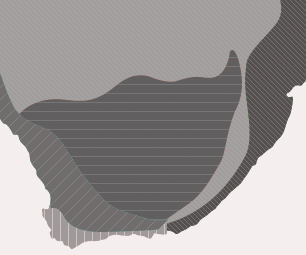
Nestlera biennis (Jacqu.) Spreng.
Family:
Common names: None known
Plant Attributes:
Plant Type:
SA Distribution:
Soil type:
Flowering season:
PH:
Flower colour:
Aspect:
Gardening skill:
Special Features:
Horticultural zones

Microsorum Link
Family:
Common names: wart ferns
Species
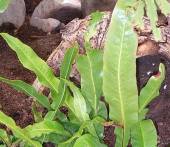
Microsorum pappei (Mett. ex Kuhn) Ching - Pappe's wart fern
The species is named after K.W.L. Pappe, the first colonial botanist at the Cape. The species is rare throughout its distribution, occurring from Madagascar to Tanzania, Mozambique, Zimbabwe and South Africa. In South Africa it is known from only a very restricted area in the KwaZulu-Natal midlands occurring in upland, moist, evergreen forests at about 750 mm above sea level. See more info below.
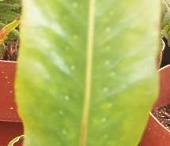
Microsorum pappei (Mett. ex Kuhn) Ching - Pappe's wart fern
Microsorum pappei has a widely creeping rhizome up to 3 mm in diameter with fronds spaced about 30 mm apart. The leaf stalk grows up to 120 mm long, and the glabrous, simple, narrowly elliptic lamina is up to 370 x 80 mm. The circular sori are 1.5 to 2.5 mm in diameter, and occur half-way between the midrib and the margin in one or two rows on either side of the costa.
The species is not available in the trade, but should it become available, it must be grown in light to deep shade in an environment with a high humidity. The species should be grown in a loose, well-drained medium that should always be kept moist.
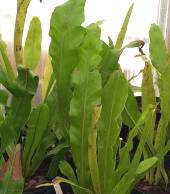
Microsorum punctatum (L.) Copel.-pitted wart fern
The specific epithet punctatum refers to the minutely pitted or dotted nature of the lamina.
Microsorum punctatum is widespread in the Old World, occurring from the Pacific islands, Malesia, tropical Asia and southern China to India , Madagascar and Africa. In Africa it occurs from West Africa through central to tropical East Africa to the east coast of South Africa as far south as Port St Johns. It is a predominantly low-altitude species occurring from near sea level to 1 500 m. The species rarely occurs on the ground, but more frequently in leaf litter and mosses on rocks in the forks of trees, often high above the ground. See more info below.
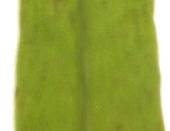
Microsorum punctatum (L.) Copel.-pitted wart fern
Microsorum punctatum has a short, creeping rhizome up to 4 mm in diameter and is covered with a thick felt of roots. The fronds are short-stalked and up to 10 mm apart. The narrowly elliptic lamina is simple, and up to 1500 x 110 mm. It has a thin leathery texture and is minutely pitted. The sori are about 1 mm in diameter and are irregularly scattered on the undersurface of the lamina.
The species is ideal for cultivation indoors and outdoors provided that it is planted in deep shade, never exposed to direct sunlight and kept moist at all times. An increased humidity will be beneficial. The species is best cultivated in a well-drained humus-rich medium kept moist at all times.
Uses: A tea of the plant is drunk for coughing fits. The leaf sap has also been reported to be used as an enema.
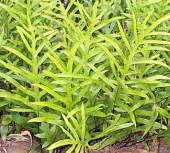
Microsorum scolopendria (Burm.f.) Copel.-embossed fern
The specific epithet scolopendria refers to the scalloped nature of the lamina.
Microsorum scolopendria , formerly known as Phymatodes scolopendria, is widespread in the Old World, occurring from Australia , throughout Polynesia and Asia and extending to Madagascar and Africa. In Africa it occurs from West Africa, throughout tropical Africa to the east coast of South Africa as far south as Port St Johns. In South Africa it mostly occurs in dune forests and dune scrub, near sea level. See more info below.

Microsorum scolopendria (Burm.f.) Copel.-embossed fern
Microsorum scolopendria has a widely creeping rhizome up to 10 mm in diameter that mostly occurs on the soil surface. The deeply pinnatifid, leathery fronds, up to 0.9 m long, are widely spaced along the rhizome. The stipe (leaf stalk) is up to 400 mm long. The leaf blade is divided into narrowly oblong lobes, up to 220 x 30 mm. The somewhat sunken sori are round to oval, 2 to 3 mm in diameter and occur in one or two rows on either side of the costa. Adaxially the sori are embossed.
This is a hardy species and easy to cultivate in a wide range of habitats. It is best cultivated outdoors in light shade, but it will also tolerate direct sunlight for part of the day. In older gardens it often establishes on brick or stone walls, or on trees, especially palms. Although it will tolerate short, dry spells it is best cultivated in conditions which remain constantly moist.
Uses: For abscesses, a paste of ground leaves mixed with earth from a wasp's nest is applied. For wounds, leaf pulp is used as a dressing, and for insanity, leaves are ground in water and the liquid drunk.
Plant Attributes:
Plant Type:
SA Distribution:
Soil type:
Flowering season:
PH:
Flower colour:
Aspect:
Gardening skill:
Special Features:
Horticultural zones

Merciera A.DC.
Family:
Common names:
Species

M. leptoloba A.DC.
Prostrate shrublet. Leaves scattered to crowded, lower leaves longer than 8 mm. Flowers are white, the corolla tube as long as the corolla lobes. Flowering time is from November to March. This species is common on the Cape south-east coast, from Kogelberg to Bredasdorp, where it grows on sandy or rocky flats and hills.
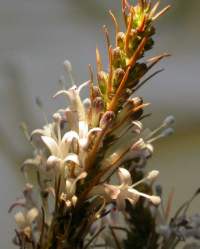
M. tetraloba C.N.Cupido
Erect, slender shrublet. Leaves scattered and mostly ascending. Flowers white, occasionally with purple or pink tips. All floral parts are in fours, which is a unique feature. The corolla tube is much longer than the lobes. Flowering time: November to January. It grows on flats and lower mountain slopes in clayey soil. Records of this species exist for Faure, Gordon's Bay, Sir Lowry's Pass, Somerset West, Strand, Dal Josaphat, Du Toitskoof, Stellenbosch, Hermon and Malmesbury.
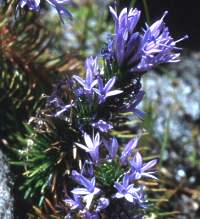
M. azurea Schltr.
Stout prostrate shrublet. Leaves crowded, axillary clusters of smaller leaves occasionally present. Flowers purple, corolla tube wider than in the other two purple-flowered species. Flowering time: November to February. This species ranges from Sir Lowry's Pass to Bredasdorp and occurs on sandy or stony soil.
Plant Attributes:
Plant Type:
SA Distribution:
Soil type:
Flowering season:
PH:
Flower colour:
Aspect:
Gardening skill:
Special Features:
Horticultural zones

Malephora N.E.Br.
Family:
Common names: mesemb ( Eng. ); vygie (Afr.)
Plant Attributes:
Plant Type:
SA Distribution:
Soil type:
Flowering season:
PH:
Flower colour:
Aspect:
Gardening skill:
Special Features:
Horticultural zones

Lobostemon Lehm.
Family:
Common names: pajama bush
Species
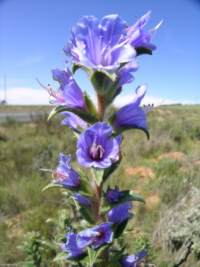
Lobostemon argenteus
The leaves are lanceolate to ovate in shape and possess long and short hairs. The inflorescence is cymous (the topmost bloom flowers first), restricted to two flowers per cyme. The flowers are medium in size (rear petals being 17-30 mm long), bell-shaped and fused below to form a tube; the 5 sepals are lanceolate in shape; dissimilar in width, shorter than half of corolla tube as well as unfused to each other; the 5 petals are predominantly violet-blue and hairless on the outside. The 5 stamens are shortly fused with the petals; the staminal scales occur well below the entrance of the corolla tube, are reduced to ridges and do not possess lateral lobes. Styles are hairy.
Lobostemon argenteus flowers mainly from August to November, although flowering specimens have been collected as late as April in the Caledon region It exhibits a disjunct distribution, occurring in three distinct regions. Current field work has resulted in re-collections within the boundaries of the Western Cape.Attempts to re-collect in the Kamiesberg vicinity and near Grahamstown have failed. The present disjunct distribution of L. argenteus is probably indicative of a once widespread distribution.

Lobostemon echioides
The leaves are narrowly oblong, lanceolate or ovate in shape and possess hairs similar in length. The inflorescence is cymous, with a large number of flowers per cyme. The flowers are small in size (rear petals less than 17 mm long), rotate in shape and fused below to form a corolla tube; the 5 sepals are lanceolate in shape, similar in width; and shorter than half of corolla tube as well as unfused to each other; the 5 petals are predominantly violet-blue and hairy on the outside (hairs largely confined to petal lobes). The 5 stamens are free from the petals above staminal scales; the staminal scales occur near the entrance of the corolla tube and are well developed, possessing lateral lobes. Styles are hairless.
Lobostemon echioides flowers mainly from August to October, but collections of flowering specimens have been made throughout the year. Plants flowering from February to May, appear to be confined to the southern parts of the species distribution range. This region often receives rain throughout the year (although in limited quantities). It is one of the most successful species in the genus from a distributional point of view, occurring almost throughout the entire total distribution range of the genus.
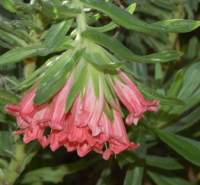
Lobostemon belliformis
The leaves are oblanceolate in shape and possess hairs similar in length. The inflorescence is cymous, with a large number of flowers per cyme. The flowers are large (rear petals longer than 30 mm); tubular in shape and fused below to form a corolla tube; the 5 sepals are oblong in shape, similar in width with two to four sepals partly fused; the 5 petals are predominantly pink to red and hairy on the outside. The 5 stamens are fused to the petals above staminal scales (for 5 mm or longer); staminal scales occur well below the entrance of the corolla tube. They are reduced to mere swellings and do not possess lateral lobes. Styles are hairy.
The plants grow mainly on stabilized sand dunes near Gouriqua, flowering from September to middle October. The showy and abundant red flowers attract birds, particularly the Orangebreasted and Lesser Doublecollared Sunbirds ( Nectarina violacea and N. chalybea ) as well as the Cape Sugarbird ( Promerops cafer ). See more about this plant.

Lobostemon glaucophyllus
The leaves are lanceolate or oblanceolate in shape and possess hairs that are similar in length. The inflorescence is cymous, with a large number of flowers per cyme. The flowers are small (rear petals less than 17 mm long), bell-shaped and fused below to form a corolla tube; the 5 sepals are lanceolate, similar in width; and unfused to each other; the 5 petals are predominantly violet-blue and hairless on the outside. The 5 stamens are shortly fused to the petals above the staminal scales (less than 5 mm); staminal scales occur well below the entrance of the throat of the corolla tube and are well developed and possess lateral lobes. Styles are hairy.
Lobostemon glaucophyllus flowers mainly from July to November. It is widespread, occurring from Nieuwoudtville in the north to Franschoek in the south and as far as Gamka Mountain Nature reserve in the east. It frequently occurs on granitic soils towards the southern reaches of its distribution range, but also occurs in the more limey soils of the Sand Plain Fynbos as well as sandstone soils of the Mountain Fynbos vegetation.
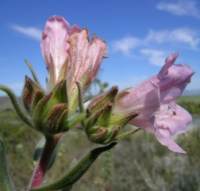
Lobostemon curvifolius
The leaves are narrowly oblong to oblanceolate in shape and possess hairs similar in length. Inflorescence is cymous, with a large number of flowers per cyme. The flowers are large (rear petals longer than 30 mm), bell-shaped and fused below to form a corolla tube; the 5 sepals are oblong, similar in width and unfused to each other; the 5 petals are predominantly violet-blue, or pink and hairy on the outside. The 5 stamens are shortly fused to the petals above staminal scales (less than 5 mm); staminal scales occur well below the entrance of the corolla tube, are reduced to ridges and do not possess lateral lobes. Styles are hairy.
Lobostemon curvifolius flowers mainly from August to October. The species does not appear to be confined to a single soil or vegetation type and occurs from Houw Hoek to Cape Infanta. In the western parts of its distribution range, it is mainly found in the Mountain Fynbos vegetation. Over the remaining distribution range it occurs mainly in South and South-west Coast Renosterveld. Limited collections have also been made in the Limestone Fynbos in the De Hoop area.
Plant Attributes:
Plant Type:
SA Distribution:
Soil type:
Flowering season:
PH:
Flower colour:
Aspect:
Gardening skill:
Special Features:
Horticultural zones

Lobelia L.
Family:
Common names:
Species
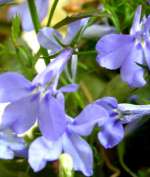
Lobelia erinus L.
Annual or perennial. Erect or spreading, growing up to 100 mm high. The leaves are rotund-ovate, spatulate or obovate-oblong, ± 10 x 4-8 mm. The inflorescence is in a loose raceme arrangement. Flower colour ranges from blue, violet, pink or white and mostly with white markings in the centre. The corolla is 8-14 mm long. The fruit is a capsule, obconical-oblong, 5-8 mm long. The flowering time is between September and December. The preferred habitat is lower mountain slopes and coastal flats. Distribution ranges from the Bokkeveld Mountains to tropical Africa.
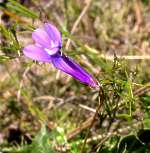
L. coronopifolia L.
A tufted shrublet, basally branched which grows up to 300 mm high. The leaves are sessile or sub-sessile, linear-lanceolate, 25-40 x 2-5 mm. The peduncle is axillary and terminal, generally 1-2-flowered. The corolla is purple-violet with exceptions of pink and white, glabrous, ± 20 mm long. The capsule is oblique-ellipsoid. The flowering period is between October and April. It occurs on sandy and stony flats as well as on lower mountain slopes. The species is mostly distributed in the Cape, especially Table Mountain but also occurs on the south and east coasts.
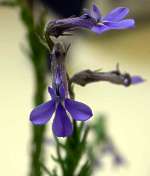
L. pinifolia L.
An erect shrublet which grows up to 300 mm high. The leaves are sessile, pointing upwards, 10-20 x 1-2 mm. Inflorescence is axillary and solitary. The corolla measures between 15-17 mm and is blue. The capsule is ovoid, 5 mm long. The flowering time is mainly between December and April and it prefers rocky slopes and flats. Distribution ranges from the Cape Peninsula to Riversdale.
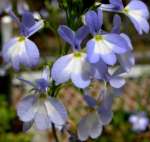
L. comosa L.
This soft, glabrous shrublet grows up to 0.5 m and is basally branched. The leaves are indistinctly petiolate or sessile, oblanceolate, 1.5-5.0 x 0.2-0.5 mm. The inflorescence is a raceme. The corolla is about 12 mm long and bright blue. The capsule is obconical. The flowering period is mainly August to January. Sandy, coastal slopes are preferred and the species ranges from Cape Peninsula to Caledon.
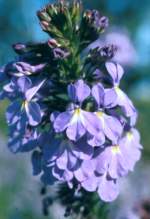
This species is commonly known as the galjoenblom . It is a soft, leafy shrublet and grows up to about 0.6 m high. The leaves are sessile, oblong-obovate, 40-100 x 4-18 mm. The corolla is deep blue, 17 mm long. The flowering time is between November and April. It occurs on the coastal hills of the Agulhas Plain from De Hoop to Stilbaai.
Plant Attributes:
Plant Type:
SA Distribution:
Soil type:
Flowering season:
PH:
Flower colour:
Aspect:
Gardening skill:
Special Features:
Horticultural zones

Leysera gnaphalodes (L.) L.
Family:
Common names: yellow daisy tea, dune tea bush (Eng.); geelblommetjietee, duinetee, hongertee, teebos, skilpadtee, teringtee (Afr.)
Plant Attributes:
Plant Type:
SA Distribution:
Soil type:
Flowering season:
PH:
Flower colour:
Aspect:
Gardening skill:
Special Features:
Horticultural zones

Lebekia Thunb.
Family:
Common names: ganna (Afr.)
Species
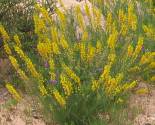
Lebeckia ambigua has a predominantly coastal distribution from Namaqualand south to the West Coast. It has leaves with an indentation near the middle, small flowers and linear, straight or falcate (curved like a sickle) pods that burst open to release the seeds. This species is typically found in deep sand or disturbed roadsides.

L. contaminata is a widely distributed species that occurs from Algeria to the Cape Peninsula and east to Bredasdorp. It has a decumbent or sprawling habit, leaves with an indentation near the middle and laterally compressed, stalked pods containing light pink seeds with a rough surface.
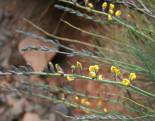
L. pauciflora is the most widely distributed of all Lebeckia species and occurs from the Kamiesberg south to Caledon and eastwards as far as Steytlerville. It has articulated (northern and southern populations) and non-articulated (eastern populations) leaves, calyx lobes that are longer than the tube, keel petals that are spirally twisted and large, flat pods.
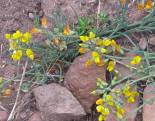
L. plukenetiana is distributed from the Cape Peninsula to Piquetberg, Hex River and Worcester and favours mountain slopes. It has unarticulated leaves, wing petals that are longer than the keel petals and is one of only two species that have a narrowly winged upper suture of the pod (the other is L. meyeriana).
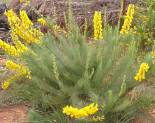
L. sepiaria is arguably the most striking and well-known of the species. It is distributed from Clanwilliam to Worcester and east to Swellendam. It has an erect habit, dense leaves, many-flowered inflorescences and pods that are round in cross-section and do not burst open to release the seeds.
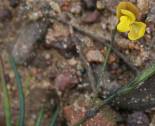
L. wrightii is an annual pyrophyte or fireweed that occurs from the Cape Peninsula eastwards to Kogelberg and the Palmiet River Mountains. This species and L. uniflora are unique in the genus in that they have small, rudimentary stipules and hairs on the leaves, bracts, bracteoles and calyx. It has a spirally twisted keel (like L. pauciflora), large obovate wing petals, flat, straight pods and rugose black seeds mottled with white.
Plant Attributes:
Plant Type:
SA Distribution:
Soil type:
Flowering season:
PH:
Flower colour:
Aspect:
Gardening skill:
Special Features:
Horticultural zones

Lasiospermum bipinnatum (Thunb.) Druce
Family:
Common names: ganskweek, gansbossie (Afr.); cocoonhead (Eng.)
Plant Attributes:
Plant Type:
SA Distribution:
Soil type:
Flowering season:
PH:
Flower colour:
Aspect:
Gardening skill:
Special Features:
Horticultural zones







Rate this article
Article well written and informative
Rate this plant
Is this an interesting plant?
Login to add your Comment
Back to topNot registered yet? Click here to register.